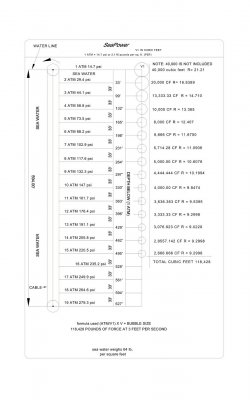- Aug 6, 2017
- 5,445
- 1,311
- 140
Tying energy sources together multiplies the energy output.
Below is a short description of how this machine works. It is based on the diagram of a machine titled “SeaEngine”, see attached
(1) cubic foot of displaced seawater has a lifting force of 64 pounds (USA) when held underwater.
The two-dimensional JPG drawing titled “SeaEngine” is a cross-sectional view of the ocean from a depth of 0 (1ATM) to a depth of 495 feet= 150.88 meters or (15ATM) +/- in water depth.
The diagram shows fifteen (15) balloons on the right moving up and 15 on the other side moving down. An easier way of envisioning this is to substitute the balloons with inverted umbrellas.

When an umbrella rounds the bottom and starts to rise compressed air is pumped into the lower umbrella. The air in the umbrella will try to rise with a lifting force of 64-foot pounds per square foot.
The pull of gravity is naturalized because the same number of umbrellas going up are going down.
The drag or resistance on the system is the combined weight of the cables and umbrellas.
In this example each umbrella weighs 200 pounds. There are fifteen (15) umbrellas. The combined weight of the umbrellas is therefore (200X15) = 3,000 us pounds.
To overcome this resistance to rising 3,000/64 = 46.875 cubic feet of air needs to be injected in the lower umbrella. This will neutralize the resistance of weight.
The lifting force of any additional air injected into the system will add to its torque force.
Am I on track or have I left the rail?
NOTE:
If the text is small and hard to read—
Hold down the [ctrl] key while rolling your mouse roller up or down.
Does this work in your computer?
 -
-
Below is a short description of how this machine works. It is based on the diagram of a machine titled “SeaEngine”, see attached
(1) cubic foot of displaced seawater has a lifting force of 64 pounds (USA) when held underwater.
The two-dimensional JPG drawing titled “SeaEngine” is a cross-sectional view of the ocean from a depth of 0 (1ATM) to a depth of 495 feet= 150.88 meters or (15ATM) +/- in water depth.
The diagram shows fifteen (15) balloons on the right moving up and 15 on the other side moving down. An easier way of envisioning this is to substitute the balloons with inverted umbrellas.
When an umbrella rounds the bottom and starts to rise compressed air is pumped into the lower umbrella. The air in the umbrella will try to rise with a lifting force of 64-foot pounds per square foot.
The pull of gravity is naturalized because the same number of umbrellas going up are going down.
The drag or resistance on the system is the combined weight of the cables and umbrellas.
In this example each umbrella weighs 200 pounds. There are fifteen (15) umbrellas. The combined weight of the umbrellas is therefore (200X15) = 3,000 us pounds.
To overcome this resistance to rising 3,000/64 = 46.875 cubic feet of air needs to be injected in the lower umbrella. This will neutralize the resistance of weight.
The lifting force of any additional air injected into the system will add to its torque force.
Am I on track or have I left the rail?
NOTE:
If the text is small and hard to read—
Hold down the [ctrl] key while rolling your mouse roller up or down.
Does this work in your computer?
Attachments
Last edited:

